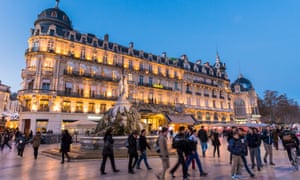Montpellier in the spotlight: development mania in France's fastest-growing city
This sun-kissed city has just become France’s seventh largest on the back of students, biotech ... and a lively skanking scene
Often overlooked for the bigger southern metropolises of Toulouse and Nice, and even Provençal tourist-draws such as Avignon and Arles, Montpellier has been the fastest growing French city over the last half-century, more than doubling in size from only 119,000 in 1962.
Growing pains
Spend five minutes on 18th-century plaza Place de la Comédie, and you’ll feel the livening effects of the city’s massive student intake, who comprise up to one-third of residents. But for some people, the growth has been too abrupt.“My feeling is that the city has lost a bit of its soul,” says Marie Laure Anselme-Martin, 70, from a local family going back four generations. “There are very few Montpelliérains with real roots – only about 15% of the population now. You could put us all in the zoo.”
The city’s journey from poky provincial capital started in the 1960s, when it was first swollen by the influx of pieds-noir (Christian and Jewish people whose families had migrated from all parts of the Mediterranean to French Algeria) and Spanish exiles from Franco. Enter outspoken socialist mayor Georges Frêche. This frank mayor once declared he would name the municipality’s cleaning-supplies room after François Mitterand: “Un pétit president, une petite salle.” (“A small president, a small room.”) His development programme – including the love-it-or-hate-it neoclassical Antigone quarter, and later the Jean Nouvel-designed town hall, a kind of black Rubik’s cube made Montpellier France’s “urbanist laboratory”. “Montpellier took off with him,” says Anselme-Martin, even though she stood in opposition to Frêche as a municipal councillor. “When he arrived, the city raised the bar very high.”
City in numbers …
300 Annual days of sunshine.2,680 Species in the Jardin des Plantes, France’s oldest botanical gardens.
82 Points with which Montpellier HSC did “a Leicester” and unexpectedly won the French football championship in 2011-12 for the sole time in their history. (They’re currently mid-table.)
37 Percentage of youth unemployment in the city – testament to ongoing economic stagnation in the south, and Montpellier’s reputation as a cushy beach-bum option.
… and pictures
There’s a Lynchian frisson to Montpellier by night, according to photographer Yohann Gozard. His local nightscapes are currently showing at La Panacée gallery’s Retour sur Mulholland Drive exhibition.History in 100 words
Unlike its illustrious neighbours, Montpellier has no Greek or Roman heritage. First mentioned in AD 985, it grew to prominence in the Middle Ages, thanks partly to a school of medicine that quickly became a European leader and is now the world’s oldest active medical faculty. Former pharmacist Anselme-Martin says Montpellier’s research culture is one of its highlights: “I bathed in it. I’ve got lots of friends in the research world, they’re people I appreciate because they’re humble.” Open-mindedness was key: in 1180, William VIII decreed that anyone, including Jews and Muslims, could practice in Montpellier – though not apothecaries, as Nostradamus, expelled for being one, would learn. Today, the medico-botanical influence is still evident in the scores of biotech and agribusiness companies.Surprisingly for a small city, Montpellier has ranked high in recent studies of France’s most congested places, rivalling Marseille and Paris. It’s less surprising when you look at the thick tangle of arterial roads and exurban sprawl surrounding it. Cutting a 12km scar through the red loam to the south of the city since 2014, is the massive A9 building site – currently the country’s largest motorway construction project, designed to siphon off all non-commuter traffic and reroute it southwards.
What’s next for the city?
With real-estate development sprouting up on every side, Montpellier’s mayor, Philippe Saurel, is still fixated on showy flagship projects. The Belaroia (“jewel” in Occitan) is a new luxury hotel and apartments complex expected to be completed opposite central Gare St Roch at the end of 2018, where a fifth tram line – a new axis linking villages to the north and southwest – may intersect by 2025.Then there is the flashy 55m L’Arbre Blanc tower, stylistically situated “between Japan and the Mediterranean”. Anselme-Martin has her doubts: “These showcase buildings – are they going to work? Can people afford this housing? Because Languedoc-Roussillon is nearly France’s poorest region. Not much work, a lot of unemployment.”
There are certainly signs of development mania. The overarching Occitan region recently withdraw its share of funding for a new €135m out-of-town train station already under construction, after learning that only four TGVs a day will stop there on its initial opening in 2018.
With all this activity, one thing is sure: Nantes, France’s sixth biggest city with a population of about 285,000, is now in Montpellier’s sights.

No comments:
Post a Comment